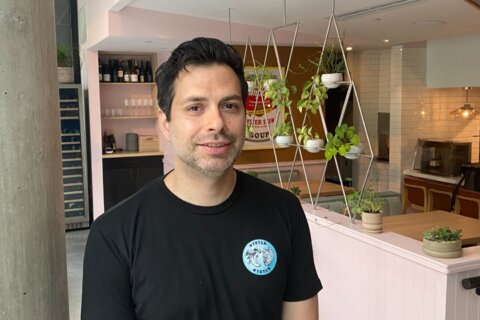WASHINGTON — Cliff Wharton has no idea what initiated D.C.’s recent obsession with Filipino food, but he thinks it’s awesome.
The Philippine-born chef recently opened Robert Wiedmaier’s Urban Heights, one of four Filipino restaurants and pop-ups set to debut this year.
“It’s like the whole Filipino thing is starting to evolve,” says Wharton, a former chef with Matchbox Food Group and TenPenh. “For some reason, it wasn’t around [a few years ago], but … these last three months … it started popping up everywhere; people started talking about it. … And why? I think people are starting to realize it’s good food and that it is table-worthy.”
Wharton, whose family moved to Kansas City from the Philippines when he was 5, says it’s difficult to compare Filipino cuisine to any other, mostly because it draws on a variety of influences, including Spanish, Malaysian and Indonesian.
“I think it’s pretty unique to itself, with all of the different influences,” he says.
On a typical Filipino menu, one can expect to find “a lot of rice, a lot of braised meats” and sweet and sour flavors. Lumpia is a popular dish in the cuisine — Wharton compares it to a spring roll, only with a thinner wrapper.
“There was always Filipino food and I was always sneaking lumpia out of the house for my friends,” says Wharton, who serves the fried rolls at Urban Heights. “It’s just something I grew up with and it stuck with me all of these years.”
Chicken adobo is another Filipino staple. “It’s like gumbo is to New Orleans cuisine,” Wharton says.
Filipino is just one of several Southeast Asian-inspired restaurants to open in the District this past year. In December, D.C. welcomed its first Laotian restaurant when Thip Khao opened in Columbia Heights.
Why, in such an international city, is D.C. just now seeing a boom in formerly underrepresented cuisines? Kathy Hollinger, president and CEO of the Restaurant Association of Metropolitan Washington (RAMW), says a lot of it has to do with D.C.’s diners and the city’s growing population.
“What we saw in the past was that there was somewhat of a need for the chef to have a one-size-fits-all approach to menu development. We were catering to maybe visitors that were coming in to the city,” Hollinger says.
“What we’re seeing now is that we have a regional dining scene, and we have diners whose palates are much more sophisticated and chefs have the ability and creativity to really cook what inspires them, versus what they feel they have to do, because they have a clientele who will support them.”
Redevelopment in some of D.C.’s neighborhoods, such as 14th Street, Bloomingdale and Petworth, is another reason for the restaurant revolution.
“Restaurants are really the anchor, or have become an anchor, in that community or in the development process.”
In addition to Filipino and Laotian, Hollinger says the city is also seeing more South American-inspired restaurants. Rural Society, Toro Toro, Tico and Del Campo are just a few examples of recent additions to the city’s dining options.
“Peruvian cuisine has exploded and it’s been on the high in terms of a trend list for the past three years,” she adds.
Later this month, Erin Gorman and her husband will open the Turkish restaurant Ankara in the former Levante’s space in Dupont Circle. While other restaurants serve Turkish food in the D.C. area, Gorman says few are dedicated solely to traditional Turkish dishes; many offer a fusion of Persian, Lebanese and Greek.
“Turkish cuisine has sort of been there in the background, and every once in a while, some place will pop up. But there aren’t very many places sort of four-square focused on Turkish food,” she says.
D.C. diners aren’t just getting adventurous with their taste buds; they’re getting adventurous with their travel, and Gorman says that is another reason her family decided to open Ankara.
“Turkey has become an incredibly popular tourist destination … it was named one of the top tourism destinations in the past three years, and so I think more people are interested, aware, intrigued,” Gorman says.
“They want to go to Turkey and going to a restaurant that features the food of the place you want to go is a good way to experience it before you actually get there.”
RAMW’s Hollinger adds diners’ expectations also have changed when it comes to eating out, and this has fueled the city’s trends in food.
“They’re very, very interested in having experiences versus just dining out.”







